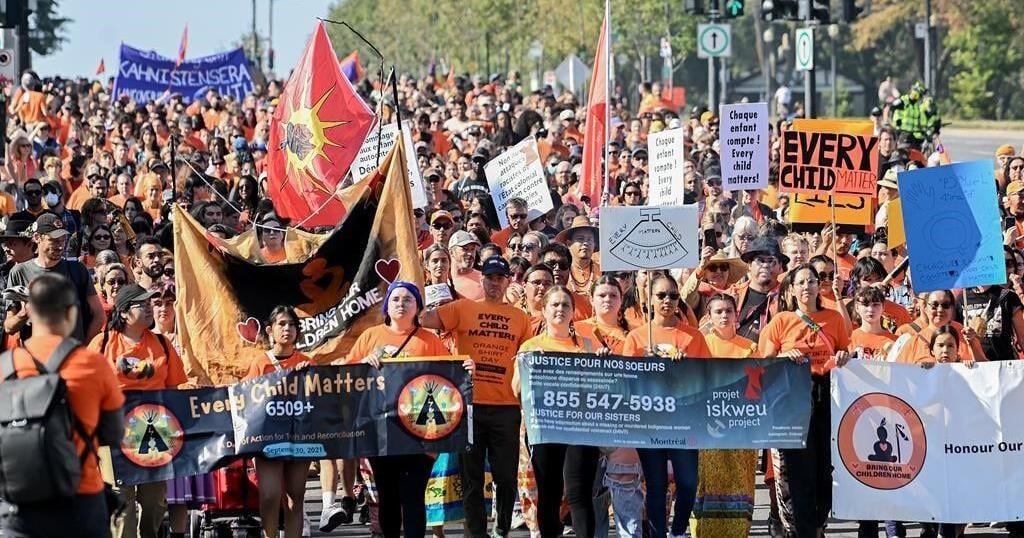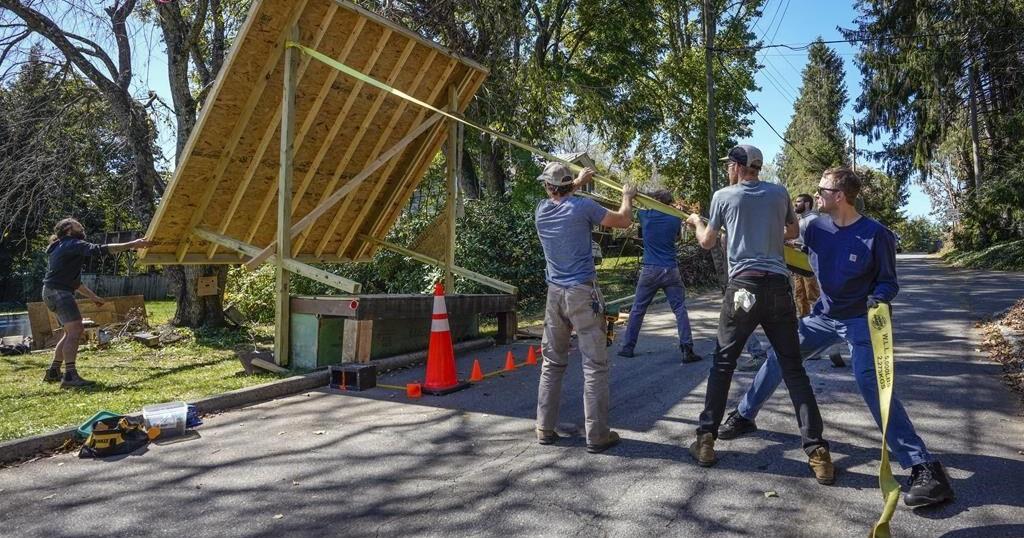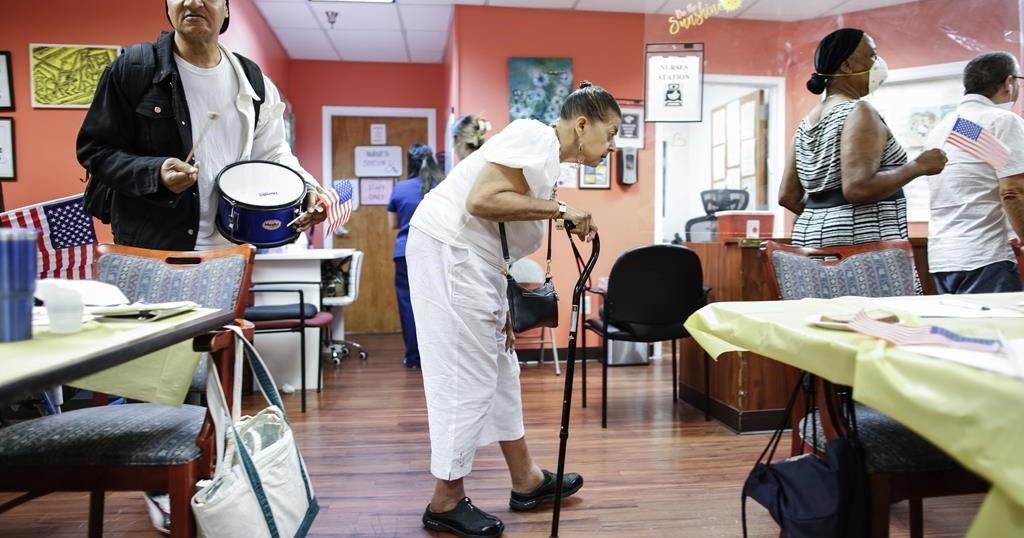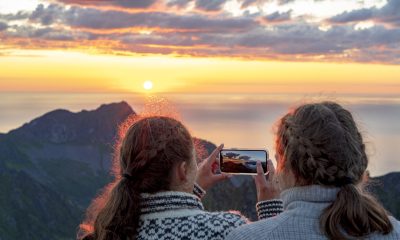The smell of sage and sweetgrass floated in the air Monday over a mostly sombre ceremony in Ottawa to reflect on the legacy of residential schools and remember those who survived — and the thousands who didn’t.
Amid the more difficult moments at the National Day for Truth and Reconciliation ceremony on Parliament Hill came a few moments of levity and celebration.
Dignitaries and children got up on their feet and started dancing. Ribbon skirts twirled and orange shirts blazed through the crowd under the heat of a late September sun.
Gov. Gen. Mary Simon, her orange T-shirt visible under a black pantsuit, stood clapping in the middle of a circle of people dancing.
Immigration Minister Marc Miller was passed a hand drum by a woman in the crowd and began to play along.
“I’ve learned a few things as the (former) minister of Indigenous Affairs over the last four years and that is not to deny Indigenous women that are about 55, 60 years old that tell you to do something,” said Miller after the ceremony wrapped up.
More than 150,000 children were forced to attend residential schools, and many survivors detailed during the Truth and Reconciliation Commission the horrific abuse they suffered.
An estimated 6,000 children died while attending the schools, although experts say the actual number could be much higher.
The ceremony was one of several across Canada to mark the day that officially began in 2021, fulfilling one of the calls to action in the Truth and Reconciliation Commission report.
Orange shirts have become a symbol of reconciliation, inspired by the story of residential school survivor Phyllis Jack Webstad, who has recounted having a new orange shirt taken from her on her first day at a residential school.
“The residential school system was intended to destroy us, and they did not succeed,” Stephanie Scott, executive director of the National Centre for Truth and Reconciliation, said to roaring applause in Ottawa.
“Our children suffered in those institutions, and to this day, their spirits call out to all of us to be remembered and honoured.”
Scott talked about the importance of believing survivors, noting her email inbox is often filled with people trying to discredit survivors’ stories.
“Denialism — it’s disgusting, it’s disheartening. And I hope that those people that deny residential school systems educate themselves one day,” she said.
Prime Minister Justin Trudeau travelled to Inuvik, N.W.T., to take part in events there. He signed an agreement on child and family services with the Inuvialuit Regional Corporation.
At a local community feast, he told the crowd that the $500-million, 10-year deal will make sure kids are protected.
Trudeau said the previous Conservative government under Stephen Harper, whose government issued an apology to former students of the residential school system in 2008, “didn’t really do anything on reconciliation.”
He said his Liberal government has signed landmark agreements and announced investments and partnerships with Indigenous people, and the work is changing the country for the better.
“The true journey of reconciliation will take decades,” Trudeau said.
Conservative Leader Pierre Poilievre participated in a different event with Indigenous leaders and, in a statement, recalled the “dark history of excessive government overreach” that brought long-lasting suffering to Indigenous communities.
“Indigenous peoples must have the freedom to determine their futures, preserve their languages, develop their resources, use their talents and celebrate their cultures,” he said. “Through a new approach and through the unmatched resilience of Indigenous people, Canada can achieve reconciliation and a brighter future for all.”
NDP Leader Jagmeet Singh marked the day in Thunder Bay, Ont., at the Honouring Our Children Run. He also attended a feast at Fort William First Nation.
“Reconciliation isn’t politics — it’s about justice,” Singh said in a social media post. “As a country, we must take responsibility and act.”
In Fredericton, Amanda Myran Dakota of Wolastoqey First Nation sat with elders holding a drum, which she later played at a ceremony.
Since Truth and Reconciliation Day was created, she said, “there have been some baby steps, but there is a lot of work that has to happen.”
The number of Indigenous children in foster care amount to a “modern-day residential school,” she added.
Na’kuset, executive director of the Native Women’s Shelter of Montreal and an organizer of a ceremony in Montreal, said she hoped to see more young people get involved in the movement.
The Truth and Reconciliation Commission report has been around for nearly a decade, she said, but only 11 of its 94 calls to action have been implemented.
“So who’s going to do it if the adults now, the current government, isn’t going to implement them? We’re hoping that next generation is going to do it,” she said.
Noella Mckenzie, an Innu elder and residential school survivor, said she came for the same reason others did.
“We are stronger together,” Mckenzie said. “I spent 10 years in a residential school … I told myself we must always give hope to our kids of the future, so that they know what we’ve experienced.”
Sarita Censoni attended a ceremony at Toronto’s Nathan Phillips Square with a friend.
“It is a time for us to heal, to help our Indigenous communities, to move forward, to understand there is no truth without reconciliation,” she said.
Riscylla Shaw, a grandchild of a residential school survivor, called the residential school system a painful part of the country’s history — and its present.
“It is a very painful part of the current way of being that so many Indigenous communities don’t have fresh water, don’t have access to health resources, education resources, fresh food,” she said.
In British Columbia, where a provincial election campaign is underway, the main party leaders turned their attention to the day with a political lens.
NDP Leader David Eby took his family, all dressed in orange, to a ceremony at the University of British Columbia.
B.C. Conservative Party Leader John Rustad said if his party is elected it would partner with First Nations to find prosperity through resource projects. He earlier pledged to repeal legislation on B.C.’s adoption of the United Nations Declaration on the Rights of Indigenous Peoples.
This report by The Canadian Press was first published Sept. 30, 2024.
— With files from Michael MacDonald in Halifax, Hina Alam in Fredericton, Sidhartha Banerjee in Montreal, Lisa Johnson in Inuvik, Sharif Hassan in Toronto, and Darryl Greer and Brenna Owen in Vancouver























